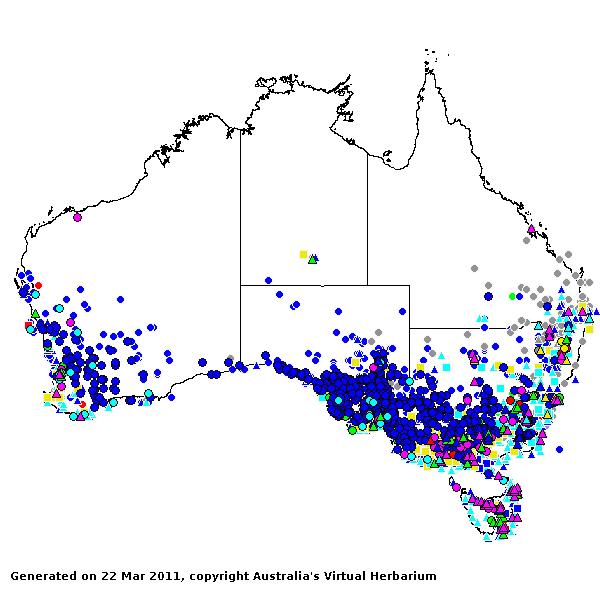Bromus* Sp. Pl. 76 (1753).
Derivation:. From Greek bromos (oats), the ancient Greek name for the related genus Avena.
Taxonomic revisions, nomenclatural references:. P.Smith, Notes Roy. Bot. Gard. Edinburgh 30: 361–375 (1970).
Key references (keys and floras):. G.Bentham, Flora Australiensis 7: 660–662 (1878), incl. Ceratochloa; C.A.Gardner, Flora of Western Australia 1 Gramineae 98–99 (1952), 94–98 as Serrafalcus and 102–104 as Ceratochloa; E.E.Henty, Manual Grasses New Guinea 43 (1969); M.Lazarides, Flora of Central Australia 432 (1981); J.C.Tothill and J.B.Hacker, Grasses of Southern Queensland 140–142 (1983); J.P.Jessop, Flora of South Australia 4: 1878–1882 (1986); B.K.Simon, Key to Australian Grasses 80–82 (1993); S.W.L.Jacobs and S.M.Hastings, Flora of New South Wales 4: 628–633 (1993); N.G.Walsh, Flora of Victoria 2: 501–508 (1994); D.I.Morris, Student's Flora of Tasmania 4B: 286–292 (1994); E.Edgar and H.E.Connor, Flora of New Zealand 5: 355–372 (2000); D.Sharp and B.K.Simon, AusGrass (2002); J.P.Jessop, Grasses of South Australia 253–260 (2006); S.W.L.Jacobs, R.D.B.Whalley & D.J.B.Wheeler, Grasses of New South Wales, 4th Ed, 172–177 (2008); A.Wilson (ed.), Flora of Australia 44A: Poaceae 2: 80–93 (2009).
W.D.Clayton & S.A.Renvoize, Genera Graminum (1986), genus (225).
Native and naturalised (B. arenarius recorded as native but this is doubtful). About 150 species, from north temperate regions, tropical mountains, South America. 15 species in Australia, WA, SA, Qld, NSW, Vic, and Tas. Also New Guinea, Malesia and New Zealand.
Habit. Annual or perennial, rhizomatous or stoloniferous or tufted or decumbent. Leaf blades broad or narrow. Ligule an unfringed membrane.
Inflorescence. Inflorescence a single raceme (rarely) or paniculate, an open panicle with branches ending in single spikelets, open or contracted, espatheate.
Spikelets. Spikelets laterally compressed, more than 2 flowered, with 2 or more fertile florets, unawned or awned, solitary, pedicelled; with naked rachilla extension. Fertile spikelets disarticulating above glumes.
Glumes. Glumes unequal (usually) or more or less equal (rarely), shorter than adjacent lemmas, pointed, awnless, keeled or non-keeled, similar (herbaceous, persistent). Lower glume 1–5(–7) nerved. Upper glume 3–7(–9) nerved.
Florets. Fertile florets 3–30 (rarely 1–2). Lemmas similar in texture to glumes to decidedly firmer than glumes (herbaceous to subcoriaceous, the margins sometimes membranous), not becoming indurated, incised (usually) or entire at apex (rarely), when incised deeply cleft or not deeply cleft, muticous or mucronate or awned, without a germination flap, 5–15 nerved, hairy or glabrous, 1 keeled or not keeled. Awns when present, 1, from a sinus or dorsal, non-geniculate, much shorter than body of lemma to much longer than body of lemma. Palea relatively long to conspicuous and relatively short, entire to apically notched, 2 nerved. Distal incomplete florets underdeveloped. Lodicules 2. Stamens 1–3. Grain medium sized, longitudinally grooved, compressed laterally, with hairs confined to a terminal tuft. Hilum long-linear. Embryo small.
Kranz Anatomy. C3.
2n = 14, 28, 42, 56, and 70, 2, 4, 6, 8, and 10 ploid, commonly adventive.
Habitat. Mesophytic, xerophytic. Shade species and species of open habitats.
Classification. Pooideae; Bromeae.
Notes. Bromus is easily confused with Festuca. For certainty it is necessary to examine the ovary, but hairy tubular leaf-sheaths and subapical lemma awns are useful supporting distinctions, though not entirely reliable (Clayton and Renvoize, 1986).
Types Species. B. secalinus L.
Biogeographic Element. Clifford & Simon 1981, Simon & Jacobs 1990: Naturalised.


